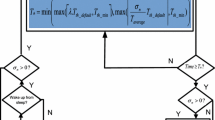Abstract
Femtocell technology has become a radical approach to improve network capacity and coverage. Because femtocells can use the same frequency bands as the cellular network, the cochannel interference is a critical issue in femto networks. To efficiently reduce interference between femto BS and other BSs, low duty mode (LDM) operation has been developed. In this work, we construct a mechanism integrating the LDM in femto BS and sleep mode in MSs to achieve higher power-saving efficiency. On the basis of the IEEE 802.16m system architecture, we build a practical system model and analyze the performance of the proposed scheme. The simulation result shows that with simple modification of sleep-cycle operation, the proposed mechanism can reduce the power consumption in femtocells. With the above characteristics, the proposed mechanism provides a solid basis for energy efficient femtocells.










Similar content being viewed by others
References
IEEE Std 802.16m-2011 (2011) IEEE Standard for Local and metropolitan area networks, Part 16: Air Interface for Broadband Wireless Access Systems: Advanced Air Interface
3GPP (2012) Service requirements for Home Node B (HNB) and Home eNode B (Release 11)
3GPP (2008) 3G Home NodeB Study Item Technical Report (Release 8)
IEEE Std. 802.16e-2005 (2006) IEEE Standard for Local and metropolitan area networks, Part 16: Air Interface for Fixed and Mobile Broadband Wireless Access Systems
Xiao Y (2005) Energy saving mechanism in the IEEE 802.16e wireless MAN. IEEE Commun Lett 9(7):595
Zhang Y, Fujise M (2006) Energy management in the IEEE 802.16e MAC. IEEE Commun Lett 10(4):311
Han K (2006) Performance analysis of sleep mode operation in IEEE 802.16e mobile broadband wireless access systems. In: IEEE 63rd vehicular technology conference
Kong L, Tsang DHK (2006) Performance study of power saving classes of type I and II in IEEE 802.16e. In: IEEE 31st conference on local computer networks, pp 20–27
Kong L, Tsang DHK (2007) Optimal selection of power saving classes in IEEE 802.16e. In: IEEE wireless communications and networking conference, pp 1836–1841
Kong L, Wong GKW, Tsang DHK (2009) Performance study and system optimization on sleep mode operation in IEEE 802.16e. IEEE Trans Wirel Commun 8(9):4518–4528
Park Y, Leem H, Sung DK (2010) Power saving mechanism in IEEE 802.16m. In: Vehicular technology conference
Baek S, Son JJ, Choi BD (2009) Performance analysis of sleep mode operation for IEEE 802.16m advanced WMAN. In: IEEE International conference on communications workshops
Jin S, Choi M, Choi S (2010) Performance analysis of IEEE 802.16 m sleep mode for heterogeneous traffic. IEEE Commun Lett 14(5):1
Kalle RK, Raj M, Das D (2009) A novel architecture for IEEE 802.16m subscriber station for joint power saving class management. In: The first international conference on communication systems and networks
Chen CY, Hsu CH, Feng KT (2010) Performance analysis and comparison of sleep mode operation for IEEE 802.16m advanced broadband wireless networks. In: IEEE 21st International symposium on personal indoor and mobile radio communications (PIMRC), pp 1425–1430
Bachir A, Dohler M, Watteyne T, Leung KK (2010) MAC essentials for wireless sensor networks. IEEE Commun Surveys Tuts 12(2):222–248
Zheng T, Radhakrishnan S, Sarangan V (2005) PMAC: An Adaptive Energy-Efficient MAC Protocol for Wireless Sensor Networks. In: IEEE international parallel and distributed processing symposium
Mhiri F, Sethomb K, Bouallegue R (2012) A survey on interference management techniques in Femtocell self-organizing networks. J Netw Comput Appl. doi:10.1016/j.jnca.2012.04.021
Widiarti H, Pyun SY, Cho DH (2010) Interference mitigation based on femtocells grouping in low duty operation. In: IEEE 72nd vehicular technology conference fall (VTC 2010-Fall), pp 1–5
Fuhrmann SW, Cooper RB (1985) Stochastic decompositions in the M/G/1 queue with generalized vacations. Oper Res 33:1117–1129
Acknowledgements
This work was supported by National Science Council, National Taiwan University and Intel Corporation under Grants NSC99-2911-I-002-001, NSC 100-2911-I-002-001, and 10R70501.
Author information
Authors and Affiliations
Corresponding author
Appendix
Appendix
We derive the steady state probability of the 15-states Markov Chain as shown in Fig. 5. The size of minimum sleep cycle size is 1 frame, and the size of maximum sleep cycle size is 8 frames. For notational convenience, we use p to represent e − λ .
Rights and permissions
About this article
Cite this article
Kuan, CC., Lin, GY. & Wei, HY. Energy Efficient Networking with IEEE 802.16m Femtocell Low Duty Mode. Mobile Netw Appl 17, 674–684 (2012). https://doi.org/10.1007/s11036-012-0390-2
Published:
Issue Date:
DOI: https://doi.org/10.1007/s11036-012-0390-2




